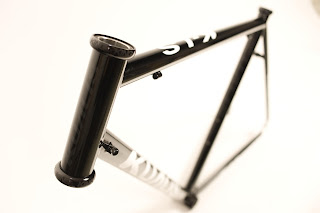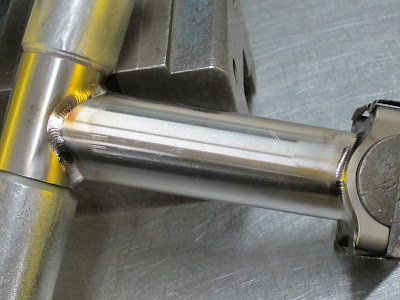*Tensile strength shows strength of material.
Elastic modulus shows stiffness of material.
Fatigue strength shows range of cyclic stress that can be applied to the material without causing fatigue failure.
This is a list which shows a relation about strength, stiffness, fatigue strength, and density for materials that are steel, titanium, and CFRP (carbon). If you look at tensile strength, titanium (3Al-2.5V) is 67% against steel, 6Al-4V is 96% (almost the same as steel), CFRP is 91%. As for strength, steel, titanium, and CFRP are excellent materials as a bike frame. As for fatigue strength, steel and titanium have long life time because of the fatigue property (If we design bikes with these materials under the fatigue limit (50-60% of tensile strength), the bikes are never distressed.) The life time of CFRP frame depends on the life time of bond (epoxy), which is more than 10 years (But this is that if you do not use a frame. By using the frame, the lifetime is about half of it (5years).).
In the meantime, if you look at elastic modulus, for example, 3Al-2.5 and 6Al-4V, they are almost the same. That means there is no difference about the stiffness between them if you make the same frames with the same specifications. (You can make larger diameter, thinner and lighter frame with 6Al-4V than 3Al-2.5V because 6Al-4V has higher tensile strength than 3Al-2.5V, but it will not be a big difference. If you want to have higher strength and stiffness of titanium, it will be necessary to improve the crystal structure of titanium. I will post about this topic later.)
Also, as a property for tubes (any material), if you make the diameter 20% larger, the stiffness becomes 1.7 times of the previous condition. For example, if you have the same diameter and thickness between steel and titanium tubes and if you make the diameter of titanium 20% larger, the stiffness becomes almost the same as steel. Of course, the weight also becomes 20% heavier, but it is still lighter than steel.
Practically, stiffness which bikers require should be various. One of the ways to make frames with different stiffness is to design the relation between the diameter and wall thickness, and to assemble them.
So you might be interested in a comparison about stiffness and weight between steel and titanium tubes? I made a list about the relation between stiffness and weight for these materials through calculating with some information of the materials and thickness personally. I will post it if I have a chance.
上の表は鉄、チタン(3Al-2.5V, 6Al-4V)、CFRP (カーボン)の強度、剛性、疲労強度、密度の関係を示したものである。例えば、強度を示す引張強度(Tensile strength)に注目すると鉄を100%とした場合、3Al-2.5Vチタンが鉄に対して67%の強度、6Al-4Vチタンが96%(鉄とほぼ同等)、CFRP(カーボン)が91% となっている。強度に関して言うならば、鉄、チタン、カーボンともにバイクフレームの素材としてはどれも優れていると言える。寿命については鉄、チタンはその疲労特性(疲労限界値が約50-60%でその数値を超えない範囲で使用する限り疲労しない。)により長寿命である。(カーボンフレームの寿命に関しては、カーボンを接着しているエポキシ樹脂の寿命(10年以上)による。しかし実際フレームの状態になり、使用される(使用度合いによるが)となるとその寿命は約半分程度となる。)
一方剛性を示す縦弾性係数(Elastic modulus)に着目してみると、例えば3AL-2.5Vと6Al-4Vチタンはそれ程の差はないといえる。つまり2台全く同じスペックのフレームを作り乗り比べた場合、その剛性感の差はほとんど無いと言える。(ただし6Al-4Vの方が強度があるため径を大きくしてチューブを薄く、軽くできるが、それも限界があり実際にはそれほどの大差は無いと言える。チタンの強度、剛性を今の基準より上げるためには、チタンの結晶構造を改良する必要があるだろう。これに関してはまた次回。)
また材質にかかわらず管の特性として、外径を20%大きくすると剛性は約1.7倍なる。20%の外径増により、質量も約20%増加するが、それでもチタンの場合、鋼材(鉄)よりは軽い。
実際、剛性に関しては人それぞれに求める大きさが異なるはずである。剛性のことなるフレームを作る一つの方法はチューブの径と厚さを変え、そのチューブの組み合わせを操作することである。
ここで興味の対象としてチタンチューブとスティールチューブの剛性と重量の関係比較ということが挙げられるかもしれない。。
実際のチューブの剛性と重量の関係(鉄とチタン)を材料の情報と厚さから計算し、個人的にリストにしてみたが、それはまた次回投稿することに。




















































